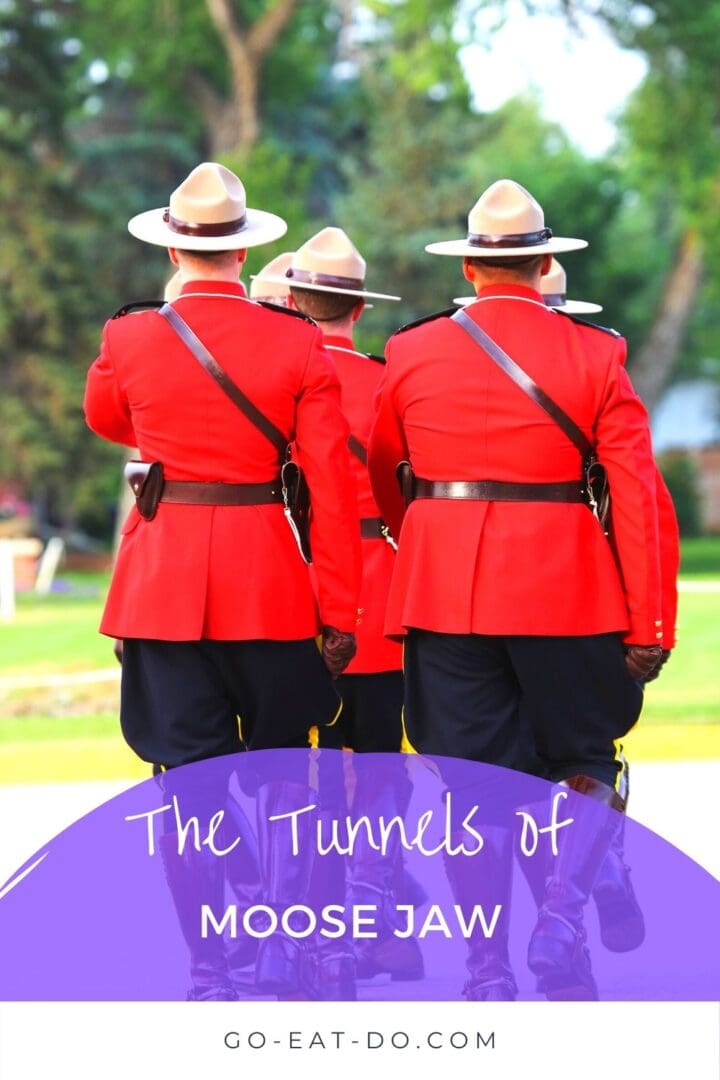Stuart Forster visits The Tunnels of Moose Jaw in Saskatchewan, Canada, and discovers how American gangsters ran alcohol into the USA from Moose Jaw during Prohibition.
Disclosure: Some of the links and banners below are affiliate links, meaning, at no additional cost to you, I will earn a commission if you click through and make a purchase.
Miss Fanny, a gangster’s moll of a lady, is speaking in a drawl. We’re in the city of Moose Jaw in Saskatchewan, Canada. She welcomes us to the Tunnels of Moose Jaw’s The Chicago Connection tour.
She’s an actor, in character, and our guide. Miss Fanny is wearing a short, 1920s-style dress and stiletto heels. She says she knows a guy called Big Al – Al Capone – and assumes myself and the rest of the tour group are here to set up an illicit booze deal.
The city of Moose Jaw
These days Moose Jaw is a quiet city with broad, well-maintained streets. Shop assistants smile welcomingly at visitors to their stores. The city makes a clean, wholesome impression.
Yet a century ago it was renowned as the sin capital of the prairies. In the 1920s it was even nicknamed Little Chicago because of its lawless behaviour. River Street was a hub for bootlegging, gambling, opium smoking and prostitution.
We learn from Miss Fanny that the chief of police in 1929, Walter P. Johnson, was notoriously corrupt. It’s said that American gangsters turned up in Moose Jaw to evade the law south of the border.
The 18th Amendment to the Constitution of the United States of America, introduced by Congress in December 1917, resulted in a nationwide prohibition of “the manufacture, sale, or transportation of intoxicating liquors” between 1920 and 1933. Demand, however, did not dry up. People able to supply alcoholic beverages during Prohibition could become rich. Al Capone’s empire was reputedly worth $100 million a year.
The Chicago Connection tour
Booze was transported south from Moose Jaw into the USA via the Soo Line. Saskatchewan had experimented with the prohibition of alcohol between 1917 and 1924 but enforcement of the law proved impractical.
We climb a flight of steps. I turn to Finn, one of my travelling companions, to ask if Canadian tunnels have a different definition to those elsewhere; shouldn’t we be heading underground rather than upstairs?
Miss Fanny shoots me a glance – maybe I shouldn’t have been talking out of turn if she has mob connections – and pulls back the door to a high-ceilinged room with a long bar.
She throws her feather boa over her shoulder, tosses back her head dramatically and welcomes us into a 1920s-style speakeasy.
She bids us to sit at one of the tables and sets the scene, with talk of hush money, corruption and illicit deals. Jaunty Ragtime-style piano music plays in what was a former Masonic meeting hall.
Al Capone in Moose Jaw
She then leads us into an office, as might have been used by Al Capone, complete with a chair with a bulletproof back. There’s strong anecdotal evidence that Capone visited Moose Jaw. A 13-year-old local lad, Ken Turner, told of delivering newspapers to him. A local doctor, Dr Hugh Young, who worked in the city from 1914 to 1968, recalled operating on Capone – without anaesthetic – to relieve pressure on tonsils inflamed by quinsy.
With talk of an imminent raid by revenue men, Miss Fanny hurries us away. Seeking refuge, we head down into the tunnels proper via a secret passage behind the office fireplace.
Once downstairs we visit the operation’s underground communications hub, complete with a Bakelite telephone and a manual switchboard. Miss Fanny then raps on a door in the brick-walled corridor and her colleague Gus peeks at us suspiciously from behind a metal grill. We exchange a ‘secret signal’ and then enter.
Tommy guns and booze
With slicked-back hair, trousers held up by braces and a trilby, Gus has a manner reminiscent of James Cagney. He leads us into a room where weapons are stored, including a Tommy gun with a barrel magazine.
He tells us how alcohol was distilled in the tunnels and then stored before being sent southward. Surely, though, the smell would have wafted out and warned anyone with a sense of smell of the operations below ground?
We pass through a card room, set up for illicit gambling, before the 45-minute tour comes to an end with a dramatic shootout.
Tunnels of Moose Jaw tours
The ticket office for the Tunnels of Moose Jaw is at 18 Main Street North in downtown Moose Jaw, Saskatchewan, Canada. In addition to selling tickets for the Moose Jaw tunnels, it hosts a souvenir shop and a gallery of framed black and white photos with scenes showing early 20th-century Moose Jaw.
The tunnels are open throughout the year. Actors in character lead visitors on two separate guided tours. The Chicago Connection tour tells the story of Moose Jaw’s links with American gangsters and bootlegging during the era of prohibition. The Passage to Fortune tells the story of early Chinese migrants to Canada.

Getting to Moose Jaw
Air Canada flies between Regina and London Heathrow via Toronto’s Pearson International Airport.
Moose Jaw is less than 50 minutes’ drive west of Regina, the provincial capital of Saskatchewan. Follow the Trans-Canada Highway (Highway 1).
The drive from Moose Jaw to Saskatoon takes around two-and-a-half hours. Much of the journey is along Saskatchewan’s Highway 11.
Moose Jaw Tourist attractions
The city of Moose Jaw’s tourism attractions include one of the locations of Saskatchewan’s Western Development Museum.
The Sukanen Ship Pioneer Village and Museum provides insights into the heritage of the province.
Buffalo Pound Provincial Park presents opportunities to explore the outdoors approximately 20 minutes drive north-east of Moose Jaw.
Mac the Moose, a giant moose statue by artist Don Foulds, stands on the edge of Moose Jaw near a jet aircraft. The Royal Canadian Air Force’s aerobatics team – the 413 Air Demonstration Squadron or Snowbirds – is based near Moose Jaw.
Further information
For more ideas about things to do in Moose Jaw, visit the Tourism Moose Jaw website.
See the Tourism Saskatchewan website for information about tourism attractions in the province of Saskatchewan.
The Destination Canada website holds information about the attractions of Saskatchewan and beyond.
Stuart Forster, the author of this post, is an award-winning travel writer and blogger based in North East England. Stuart was presented with the 2017 British Annual Canada Travel Award for Best Online Content.
If you enjoyed this post why not sign up for the free Go Eat Do newsletter? It’s a hassle-free way of getting links to posts every month.
‘Like’ the Go Eat Do Facebook page to see more photos and content.




